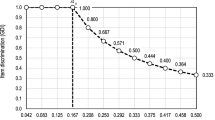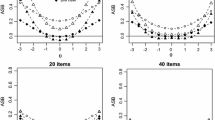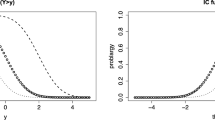Abstract
An important assumption in IRT model-based adaptive testing is that matching difficulty levels of test items with an examinee's ability makes a test more efficient. According to Lord, “An examinee is measured most effectively when the test items are neither too difficult nor too easy for him”. This assumption is examined and challenged through a class of one-parameter IRT models including those of Rasch and the normal ogive. It is found that for a specific model, the validity of the fundamental assumption is closely related to the so-called van Zwet tail ordering of symmetric distributions. In this connection, the cosine distribution serves as the borderline between those satisfying the assumption and those violating the assumption. Graphic and numerical illustrations are presented to demonstrate the theoretic results.
Similar content being viewed by others
References
Akkermans, W., & Muraki, E. (1997). Item information and discrimination functions for trinary PCM items.Psychometrika, 62, 569–578.
Birnbaum, A. (1968). Some latent trait models and their use in inferring an examinee's ability. In F. M. Lord & M. R. Novick,Statistical theories of mental test scores (pp. 395–479). Addison-Wesley, Reading, MA.
Hettmansperger, T.P. (1984).Statistical inference based on ranks. New York: Wiley & Sons.
Huynh, H. (1994). On equivalence between a partial credit item and a set of independent Rasch binary items,Psychometrika, 59, 111–119.
Huynh, H. (1996). Decomposition of a Rasch partial credit item into independent binary and indecomposable trinary items.Psychometrika, 61, 31–39.
Kotz, S., & Johnson, N.L. (1986).Encyclopedia of statistical sciences, Vol. 7. New York: Wiley & Sons.
Kotz, S., & Johnson, N.L. (1988).Encyclopedia of statistical sciences, Vol. 9. Wiley & Sons, New York.
Lord, M. F. (1970). Some test theory for tailored testing. In W.H. Holtzman (Ed.),Computer-assisted instruction, testing and guidance. New York: Harper and Row.
Lord, M. F. (1971). Robbins-Monro procedures for tailored testing.Educational and Psychological Measurement, 31, 3–31.
Lord, M. F. (1980).Applications of item response theory to practical testing problems. Hillsdale, NJ: Lawrence Erlbaum.
Rasch, G. (1960).Probabilistic Models for Some Intelligence and Attainment Tests. Copenhagen: The Danish Institute of Educational Research. (Expanded edition, 1980, The University of Chicago Press)
Samejima, F. (1979).Constant information model: A new, promising item characteristic function (ONR 79-1). Arlington, VA: Office of Naval Research.
Samejima, F. (2000). Logistic positive exponent family of models: Virtue of asymmetric item characteristic curves.Psychometrika, 65, 319–335.
Thurstone, L. L. (1925). A method of scaling psychological and educational tests.Journal of Educational Psychology, 16, 433–449.
van Zwet, W.R. (1964).Convex Transformations of random variables (Mathematical Centre Tracts, Vol. 7). Amsterdam: Mathematisch Centrum Amsterdam.
Zhang, J. (1996).Some fundamental issues in item response theory with applications, Unpublished doctoral dissertation, University of Illinois. Champaign-Urbana, IL.
Zhang, J., & Stout, W.F. (1999). The theoretical detect index of dimensionality and its application to approximate simple structure.Psychometrika, 64, 213–249.
Author information
Authors and Affiliations
Corresponding author
Additional information
Research by Peter Bickel supported by NSF Grant DMS 95-04955. Research by Steven Buyske supported by ETS Psychometric Fellowship. Research by Huahua Chang supported by ETS research allocation PJ 79427. Research by Zhiliang Ying supported by ETS Visiting Scholar Program, NSF Grant DMS 96-26750, and NSA Grant MDA 96-1-0034.
We would like to thank the Associate Editor and two referees for their helpful and constructive comments, which led to many improvements. We also thank Ming-Mei Wang and Eiji Muraki for relating our work to Samejima (1979), Fumiko Samejima for sending us her manuscript, and Charles Davis for helpful conversations.
Rights and permissions
About this article
Cite this article
Bickel, P., Buyske, S., Chang, H. et al. On maximizing item information and matching difficulty with ability. Psychometrika 66, 69–77 (2001). https://doi.org/10.1007/BF02295733
Received:
Revised:
Issue Date:
DOI: https://doi.org/10.1007/BF02295733




